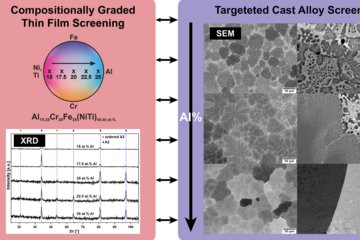All genres
761.
Journal Article
Identification of ε-martensite in Fe-based shape memory alloy by means of EBSD. Micron 40, 1, pp. 151 - 156 (2009)
762.
Journal Article
Microstructural aspects of crack nucleation during cyclic loading of AA7075-T651. Engineering Fracture Mechanics 76, pp. 709 - 714 (2009)
763.
Journal Article
Prediction of cold rolling textures of steels using an artificial neural network. Computational Materials Science 46, pp. 800 - 804 (2009)
764.
Journal Article
Modeling of dislocation patterns of small- and high-angle grain boundaries in aluminum. Computational Materials Science 46, pp. 293 - 296 (2009)
765.
Journal Article
Multiscale simulation of polycrystal mechanics of textured β-Ti alloys using ab initio and crystal-based finite element methods. Physica Status Solidi B 245 (12), pp. 2642 - 2648 (2008)
766.
Journal Article
Error-propagation in multiscale approaches to the elasticity of polycrystals. Physica Status Solidi (B) 245, pp. 2636 - 2641 (2008)
767.
Journal Article
Microtexture and Chitin/Calcite Orientation Relationship in the Mineralized Exoskeleton of the American Lobster. Advanced Functional Materials 18 (20), pp. 3307 - 3314 (2008)
768.
Journal Article
Hierarchical Modeling of the Elastistic Properties of Bone at Submicron Scales: The Role of Extrafibrillar Mineralization. Biophysical Journal 94, pp. 4220 - 4232 (2008)
769.
Journal Article
Three-dimensional EBSD study on the relationship between triple junctions and columnar grains in electrodeposited Co–Ni films. Journal of Microscopy 230, pp. 487 - 498 (2008)
770.
Journal Article
Ultrafine Grained Ferrite/Martensite Dual Phase Steel Fabricated by Large Strain Warm Deformation and Subsequent Intercritical Annealing. ISIJ International 48 (8), pp. 1096 - 1101 (2008)
771.
Journal Article
Correlation between the flow stress and the nominal indentation hardness of soft metals. Scripta Materialia 59, pp. 518 - 521 (2008)
772.
Journal Article
A comparison of polycrystalline elastic constants computed by analytic homogenization schemes and FEM. Physica Status Solidi B 245, pp. 2630 - 2635 (2008)
773.
Journal Article
Texture measurement of grain-oriented electrical steels after secondary recrystallization. Journal of Magnetism and Magnetic Materials 320, pp. e657 - e660 (2008)
774.
Journal Article
Microstrain localisation measurement in epoxy FRCs during plastic deformation using a digital image correlation technique coupled with scanning electron microscopy. Nondestructive Testing and Evaluation 3, pp. 229 - 240 (2008)
775.
Journal Article
Characterization of the microstrcture, crystallographic texture and segregation of an as-cast duplex stainless steel slab. Steel Research International 79 (6), pp. 482 - 488 (2008)
776.
Journal Article
3D tomographic EBSD measurements of heavily deformed ultra fine grained Cu-0.17wt%Zr obtained from ECAP. Materials Science Forum 584-586, pp. 434 - 439 (2008)
777.
Journal Article
On Predicting Nucleation of Microcracks Due to Slip-Twin Interactions at Grain Boundaries in Duplex gamma-TiAl. Journal of Engineering and Materials Technology 130 (02), pp. 021012-1 - 021012-12 (2008)
778.
Journal Article
A 3D tomographic EBSD analysis of a CVD diamond thin film. Science and Technology of Advanced Materials 9, 035013 (2008)
779.
Journal Article
An Inverse Approach to Determine the Mechanical Properties of Elastoplastic Materials Using Indentation Tests. Computers, Materials & Continua 7 (1), pp. 33 - 42 (2008)
780.
Journal Article
New developments in stainless steels - Impacts from markets and technology. Steel Research International 79 (6), p. 403 - 403 (2008)











